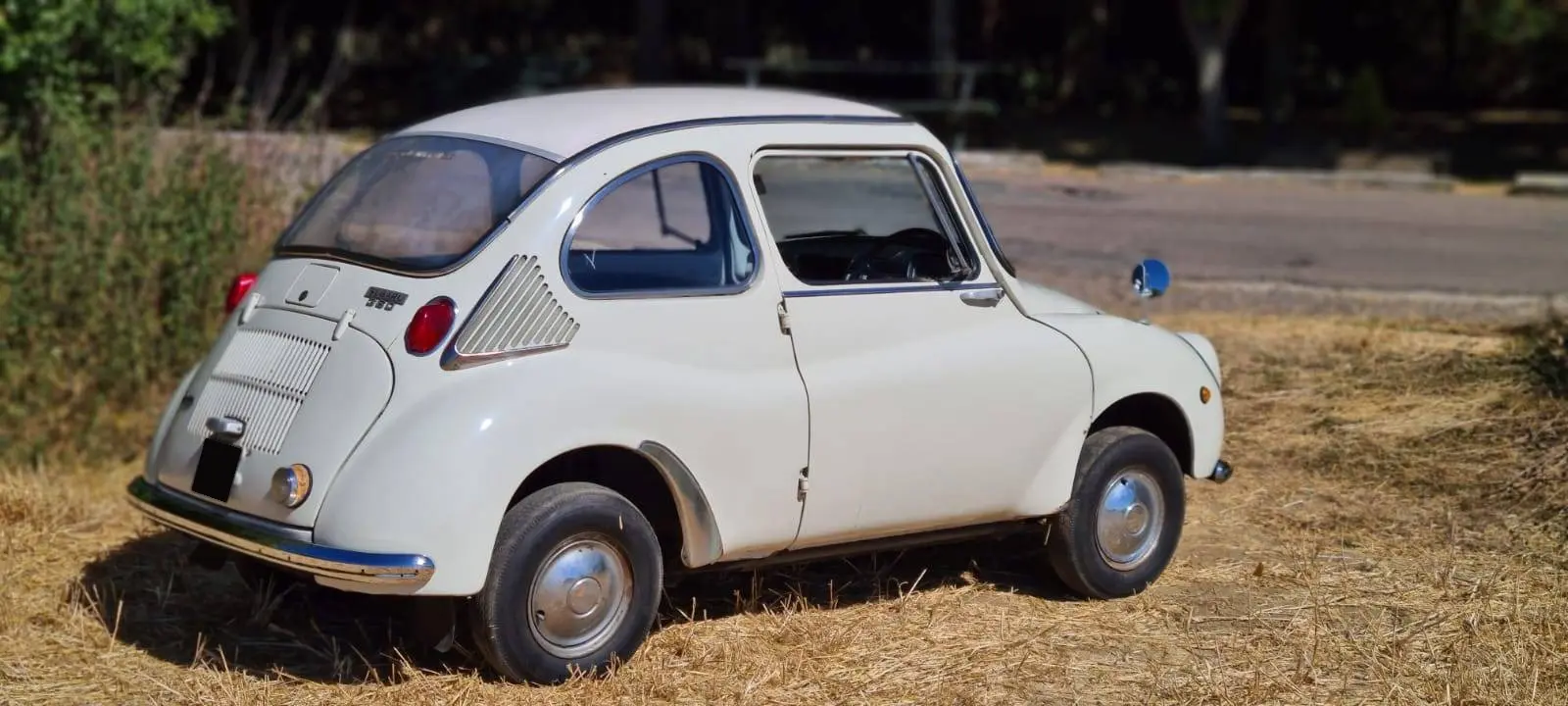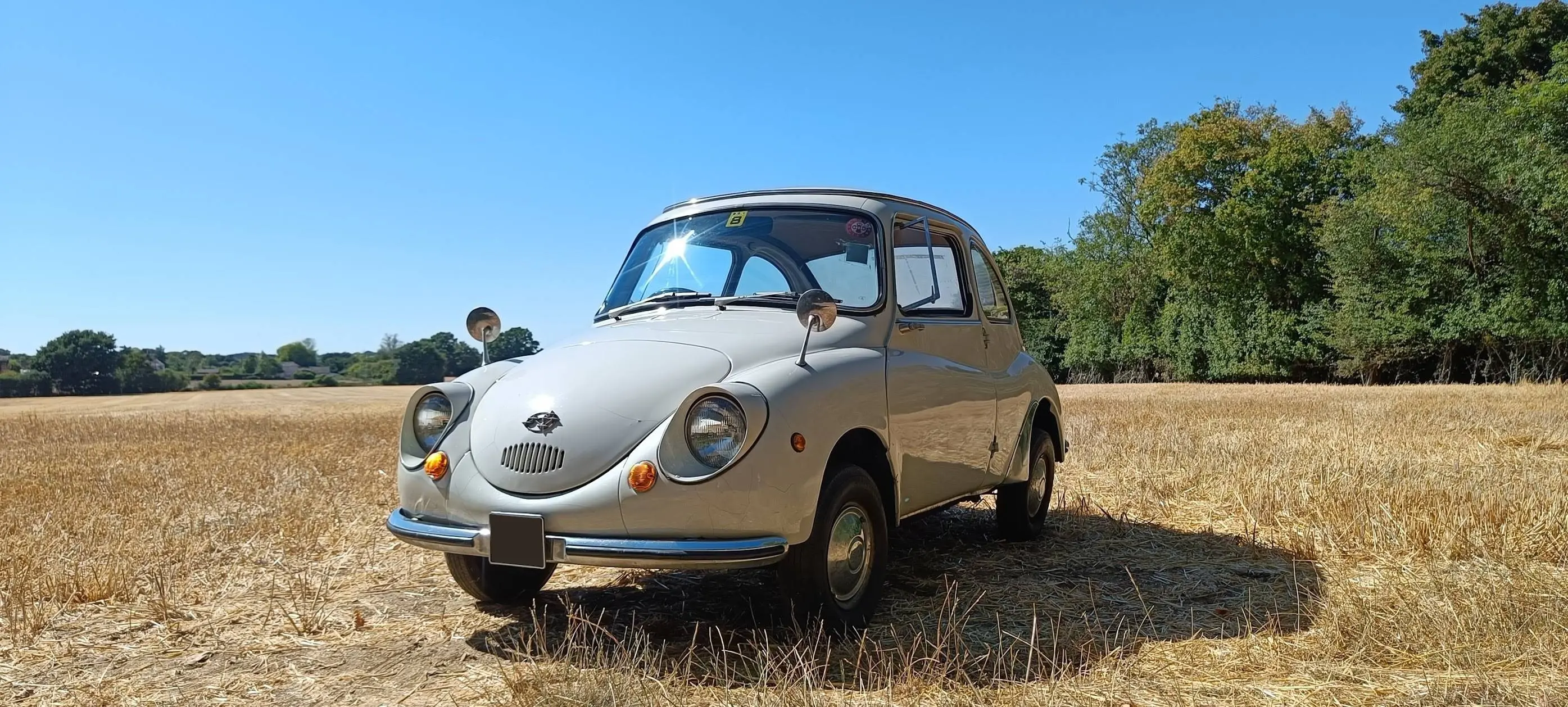THE SUBARU 360 – THE CAR THAT TRANSFOMRED JAPANESE MOTORING
13 May 2024
Bonham Cars Online is currently listing one of the most significant cars in Japanese motoring history: https://carsonline.bonhams.com/en/listings/subaru/360/37559ad3-607c-47b5-8242-9b9652b31435?open=true. This 1968 360 is an example of the vehicle that brought mobility to so many families. Not to mention that the 360 was the pioneer car to wear the Subaru badge.
Fuji Heavy Industries introduced the Subaru 360 on the 3rd of March 1958 at Toyyo’s hirogiya Department Store. It was their response to the Japanese government’s creation of the Kei Jidosha” (“Light Automobile”) market sector in 1949. By October 1954, the maximum engine size was raised to 360cc, with Kei Cars also being under 9 feet 10 inches long. They received tax concessions and exemption from the country’s stringent parking regulations. In 1958 only around three per cent of Japanese households owned a vehicle but the 360, the nation’s first mass-produced Kei car, would transform that figure.

Power for the Subaru was from a two-stroke, air-cooled 356cc engine at the rear. Fuji’s design team adopted a transverse layout to maximise passenger space and the specification included a three-speed gearbox, all-independent suspension and rack and pinion steering. To ensure the 360 weighed less than 900 lbs, Fuji fitted a GRP roof to the metal body. The top speed was 52 mph, and the 360 was capable of an impressive 73 mpg. Inside, there were four individual seats, each with a folding backrest. Those at the rear could be rolled forward to increase luggage space.
Sales commenced in May 1958, and Fuji aimed to offer the 360 for the equivalent of £425, compared with £630 for the Hino-built Renault 4CV. When Autocar tested the Subaru in 1958, it praised the “first class suspension” and the “extremely smooth” steering, but thought the transmission required synchromesh to protect it from “the assaults of a public which will be mostly new to car driving”.

And the 360 did become the “First Car” of many Japanese families. Within a few years the “Ladybird”, as the Subaru became known, was a familiar sight across the country. In August 1959, Fuji introduced the “Convertible” with a fabric sunroof, followed by a Van in December. In October 1960, Fuji introduced a new 450 variant with a 423cc engine and synchromesh on 2nd and 3rd gears, and the “Custom” estate in 1963.
By that time, motoring conditions in Japan were changing, and Autocar reported from the 1963 Tokyo Motor Show that:
As standards of living levels up, the minicars under 360cc are losing popularity despite their favourable taxation. The Subaru 360 of 1964, overloaded with ornaments, the luxury of upholstered doors with wind-up windows, and even an electro-magnetic clutch, is a far cry from the original lightweight.

In 1964, the 360 also gained a “Subarumatic” system, which mixed oil with petrol automatically to reduce engine wear. Earlier Subarus had the fuel filler lid double as a measuring cup to ensure the proper petrol/oil ratio. As a 1968 model, it had map pockets, an open glove compartment and a split front bench seat. Such features would lure potential buyers away from more recent Kei cars, such as the Honda N360.
This 360 also boasts the more elaborate fascia of the later models, with its Fiat-like speedometer. In addition, the cabin room is remarkable in a car about three inches shorter than a Mini, and the Subaru has a vast number of fascinating details. The front doors are rear-hinged, and to the right of the driver a floor-mounted lever controls a heating system that looks as though it hails from a Victorian steam ship. Possibly best of all is the “air conditioning” system – a flap ahead of the windscreen. In the experience of this writer, opening the ventilator can admit rather cross wasps into the cabin.
For the keen driver, the brilliantly named 1968 “Young S” featured twin carburettors, a rev counter and a stripe on the bonnet. Those needing even more performance could order the Young SS, with twin BS32 Mikuni Solex carburettors. Anyone who does not want to rush out and buy an SS after viewing this commercial should be sentenced to ten years of watching Crossroads –
Fuji created the Subaru 450 with export markets in mind but, sadly, it was never officially marketed in the UK. Selling a Japanese car less than two decades after the Second World War ended would have been a challenge; import duties were another problem, and the Mini would have been a formidable Subaru rival. Yet the 450’s – and the 360’s – many strong points made it a town car to compete with such imported competitors as the Fiat 600.
However, 1961 saw an early attempt at marketing the Subaru in the English-speaking world when Australian sales of the 450 commenced under the Maia name. Wheels magazine praised the “fine rack and pinion steering box” and the outstanding suspension, and believed the road holding was its finest feature. The brochure further promised “the first time you see the Maia, you will be enthralled by its beautiful lines” and “you will be thrilled by its superb accelerative power”.
Alas, Frank O’Brien of Ballarat in Victoria imported just 40 pale blue 450s. According to https://www.mysubaru360.com/, “they were unfortunately found to be prone to overheating – Subaru Japan tried all they could to fix the problem but to no avail, despite three trips over there by Mr O’Brien.” Seven years later, the 360 was marketed in the USA under the memorable slogan, “Cheap and Ugly”. This PR film further promised the Subaru was the car of choice for “groovy chicks” -
Sales are believed to have reached 6,000 by 1969. Sadly, in April of that year, Consumer Reports billed it as “unacceptably hazardous”.
But when the 360 ceased production in 1971 after 392,000 units, it had transformed mass-motoring in Japan. Subaru had brought mobility to a nation in the same way that the Fiat 600 transformed Italian society and the SEAT 600 revitalized Spanish life.
With thanks to: Freddie Woodd and https://carsonline.bonhams.com/en
Protect your classic vehicle with Japanese import car insurance from Lancaster Insurance, get covered today!
